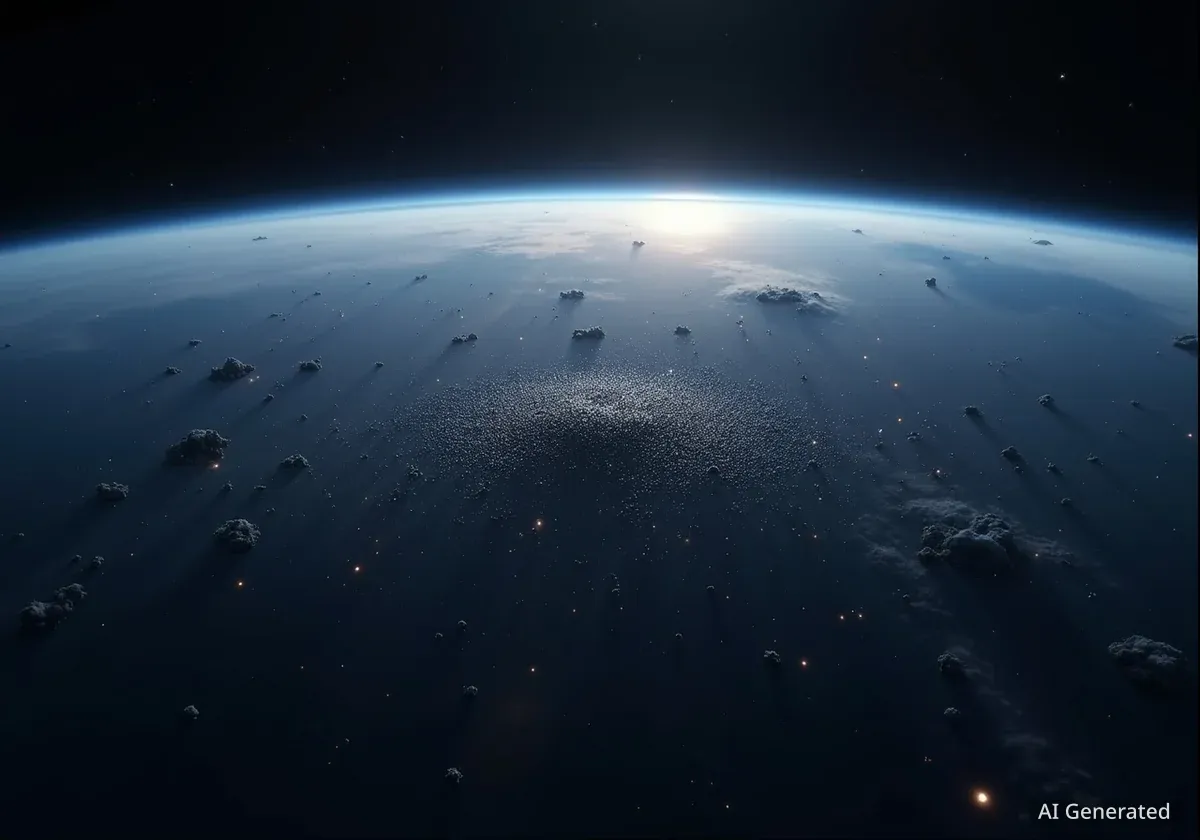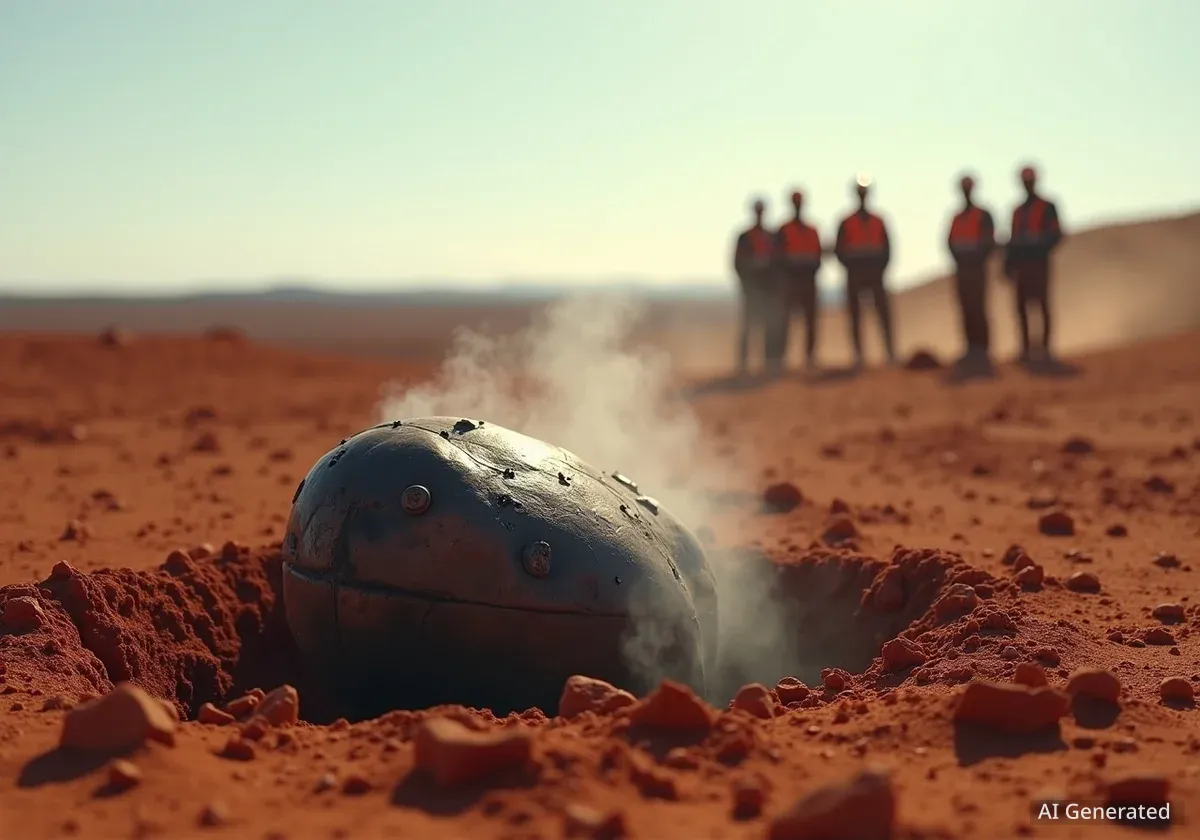Low Earth Orbit is becoming increasingly congested with man-made debris, creating a hazardous environment for active satellites and space stations. According to the European Space Agency, an estimated 140 million objects larger than one millimeter are currently circling the planet, with the total mass of orbital material reaching 14.5 million kilograms—a 63% increase over the last five years.
This proliferation of space junk is forcing satellite operators to conduct an unprecedented number of collision avoidance maneuvers. SpaceX's Starlink constellation, for example, performed 144,404 such maneuvers in the first half of 2025, a threefold increase from the previous six-month period, highlighting the escalating risk of catastrophic impacts.
Key Takeaways
- The mass of debris in orbit has surged by 63% in five years, now totaling 14.5 million kilograms.
- Satellite operators like SpaceX are performing collision avoidance maneuvers at an accelerating rate, indicating a worsening orbital environment.
- Experts believe certain orbital altitudes have already reached a density where a chain reaction of collisions, known as the Kessler syndrome, is possible.
- Proposed solutions include active debris removal, AI-powered satellite management, and new international space traffic regulations.
The Growing Threat of Orbital Congestion
The space surrounding Earth, particularly in Low Earth Orbit (LEO) where most satellites operate, is no longer a vast, empty expanse. It is now filled with defunct satellites, spent rocket stages, and countless fragments from past collisions. These objects travel at extreme velocities, with speeds exceeding eight times that of a rifle bullet, turning even tiny pieces of metal or paint into dangerous projectiles.
This situation presents a constant threat to operational spacecraft. A collision can disable a critical satellite, disrupt communication services, or endanger the lives of astronauts aboard the International Space Station and China's Tiangong space station. The challenge for operators is relentless, with collision warnings becoming a routine part of daily operations.
What is the Kessler Syndrome?
The Kessler syndrome is a theoretical scenario proposed in 1978 by NASA scientist Donald Kessler. He predicted that once the density of objects in LEO reaches a certain point, a collision could trigger a cascading chain reaction. Each impact would generate more debris, which in turn would increase the likelihood of further collisions, eventually rendering certain orbits unusable for future generations.
Critical Altitudes and Runaway Collisions
Recent analysis suggests that the conditions for the Kessler syndrome are no longer just theoretical. According to research by Donald Kessler and Professor Hugh Lewis of the University of Birmingham, the debris population between 520 and 1,000 kilometers is already at or near a level that could sustain a runaway growth of new fragments.
Darren McKnight, a senior technical fellow at LeoLabs, a company that provides high-resolution debris tracking, reinforces this concern. "There are certain altitudes where we’ve already passed the threshold for the Kessler syndrome," McKnight stated. He identified specific high-risk zones at 775 km, 840 km, and 975 km where collision risk is escalating rapidly.
Orbital Debris by the Numbers
- 140 million: Estimated number of debris items larger than 1 mm.
- 14.5 million kg: Total mass of man-made objects in orbit.
- 144,404: Starlink collision avoidance maneuvers in a recent six-month period.
- 22-fold: Increase in Starlink's avoidance maneuvers since 2020.
Analysts at LeoLabs have categorized the problem into "four waves." The first three—involving collisions between small, untrackable debris and larger objects—are believed to be underway. The fourth and most severe wave, a chain reaction started by the collision of two large objects, has not yet occurred but remains a significant possibility.
"The Kessler syndrome is a slow, crawling effect—that when it starts accelerating, it’s already too late," said Luc Piguet, CEO and cofounder of the debris-removal startup ClearSpace. "The Kessler syndrome is happening."
The Search for Sustainable Solutions
As the orbital environment deteriorates, the space community is accelerating its search for solutions. These efforts focus on three main areas: better tracking, smarter satellite operations, and active cleanup.
AI and Automated Avoidance
Artificial intelligence is emerging as a critical tool for managing large satellite constellations. AI-powered systems can process vast amounts of tracking data to provide more accurate collision warnings and execute automated avoidance maneuvers. This technology helps satellites dodge debris more efficiently, preserving fuel and extending their operational lifespan. According to Tim Flohrer, head of the European Space Agency’s Space Debris Office, "Collision avoidance is a standard practice now for every operator."
Active Debris Removal
Several companies are developing robotic missions to actively remove the most dangerous pieces of junk from orbit. Startups like Japan-based Astroscale and Switzerland-based ClearSpace are pioneering this field. Their missions aim to capture large, defunct satellites and guide them to a controlled reentry over remote ocean areas like Point Nemo in the South Pacific.
"The technology available to remove debris today is really toward larger pieces of debris," explained Andrew Faiola, commercial director at Astroscale. "We’re just maturing that capability to be able to effectively, safely, and securely remove large pieces of debris."
New Rules for Space Traffic
Technology alone may not be enough. There is a growing consensus that international agreements and regulations are needed to manage orbital space as a shared global resource. Experts argue for a system akin to air traffic control to coordinate the growing number of satellites and prevent future orbital pollution.
This is complicated by existing legal frameworks like the 1967 Outer Space Treaty, which states that objects launched into space remain the property of the launching nation. This means removing a piece of foreign debris could require international permission. To address these challenges, the United Nations is hosting a space law conference, and nations like Japan are developing their own legal frameworks for debris removal.
Rethinking Our Approach to Space
Some experts believe a fundamental shift in mindset is required. Moriba Jah, a professor at the University of Texas at Austin, argues for the concept of "orbital carrying capacity." He suggests that orbits should be managed to ensure their long-term sustainability, with equitable access for all nations.
"Right now, every single object that we launch into orbit is the equivalent of a single-use plastic," Jah said. "We need to invest in reusable and recyclable satellites."
The problem is not confined to Earth's orbit. As humanity expands its presence to the Moon and Mars, the risk of polluting other celestial environments grows. "We’re expanding outward into the solar system, and we’re just taking these problems with us," warned Katherine Courtney of the Global Network on Sustainability in Space. Establishing sustainable practices now is considered essential to preserving access to space for the future.





